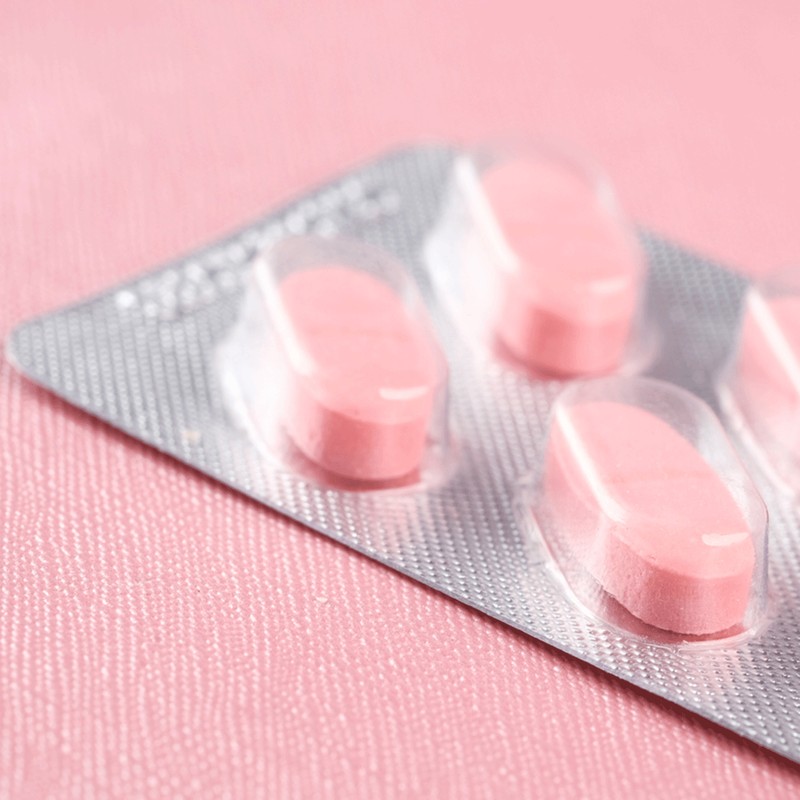Are You Oestrogen Dominant?
What Exactly Is Oestrogen Dominance?
Safe to say there’s divided opinion about what exactly constitutes an ‘oestrogen dominance’. According to nutritional therapist at Wild Nutrition Vanessa Tucker, the term is in dire need of clarification. “Either levels of oestrogen are too high or the ratio between oestrogen and another female hormone, progesterone, are out of balance,” she explains.
And why is this considered a bad thing? Vanessa says it has the potential to affect a woman’s body in many ways, disrupting their physical, emotional and mental well-being. “It can also lead to changes in menstrual cycle, mood, ability to fall pregnant, weight, and energy,” she adds, “as well as worsening specific hormone-related issues or diseases such as endometriosis, polycystic ovarian syndrome (PCOS), painful periods and fibroids.”
One thing the experts do agree on is that when you have too much oestrogen in your body, it’s important to rebalance things. “As well as regulating the menstrual cycle, oestrogen also regulates the reproductive tract, the urinary tract, the heart and blood vessels, bones, breasts, skin, hair, mucous membranes, pelvic muscles, and the brain,” warns functional nutrition practitioner, weight loss and nutrigenomics specialist Pippa Campbell. “Oestrogen can also lift our mood, help stabilise blood sugar levels and promote good bowel function. However, too much oestrogen can cause unpleasant symptoms and increase the risk of DNA damage and disease, so we need to detox it once our body has used it. Healthy detoxification is therefore of the utmost importance, especially for women experiencing any metabolic disorders.”
What Are The Classic Symptoms That Might Suggest You Are Oestrogen Dominant?
According to Dr Helen O’Neill, founder of digital health company Hertility, the list of symptoms can be varied and long. “Irregular periods are one,” she says. “Other things to look out for include abnormal vaginal bleeding; breast tenderness; bloating; weight gain; gastrointestinal disorders; fatigue; headaches, nausea and vomiting; or mood fluctuations including feeling depressed or anxious.” If you notice you are experiencing any of the above, Helen advises seeing your doctor to understand what might be causing your particular symptoms. In some cases, clinically diagnosed conditions that present themselves as a result of oestrogen dominance can include endometriosis and adenomyosis, PCOS and fibroids.
How Do You Test Your Oestrogen Levels?
Checking for elevated oestrogen levels isn’t always simple and it isn’t something that necessarily shows up on a standard blood test, so don’t despair if you have all the symptoms but your blood tests come back normal. “If this is the case, your doctor can refer you to test your FSH (follicle stimulating hormone) level on day three of your menstrual cycle,” says Vanessa. “FSH levels correspond to the amount of oestrogen being produced in the ovaries as well as checking oestrogen levels. But oestrogen is a complex hormone and levels could show as ‘normal’ even if your symptoms scream elevated oestrogen. Urine testing for oestrogen is helpful – it can show you different types of oestrogen and where problems could be occurring on the ‘oestrogen journey’ after our body metabolises this hormone.”
It’s worth getting to the bottom of, says Helen, as measuring oestrogen levels can help give you an insight into your fertility, menstrual cycle,and other health conditions. “Oestrogen levels are usually checked along with other hormones that influence your menstrual cycle including FSH and luteinising hormone (LH), to rule out the possibility of an underlying reproductive health condition. Your doctor may also test your oestrogen levels if you are undergoing fertility treatment to monitor the growth of your eggs.”

Why Might Your Oestrogen Levels Be Off?
Poor liver function for one, says Pippa. “The liver detoxifies oestrogen, so if that process is not efficient, oestrogen builds up and is not eliminated as it should be.” Then there’s weight gain. “Fat cells convert some hormones into oestrogen, so if you are overweight, this can cause levels of oestrogen to rise in the body. Equally, having excess levels of oestrogen (oestrogen dominance) could be why your weight loss is slowing down or why you’re having difficulty losing weight altogether, so it can be a vicious cycle.” This explains why it’s important to eat a plant-rich diet to support your gut health – a healthy gut has been shown to be helpful in detoxing toxic oestrogen. “Xenoestrogens are chemicals that are full of toxins which mimic oestrogen and raise levels in your body – they’re found in everyday items such as plastic bottles, metal food cans, food dye, household detergents, pesticides, insecticides, fungicides, herbicides, HRT medication, other plastics (BPA), chlorine, parabens and cigarette smoke, exhaust fumes and paint,” adds Pippa. Occasionally, an oestrogen imbalance may be the result of underlying health conditions like hypothalamic amenorrhea, which can be caused by factors such as stress, not eating enough or over exercising.
Can You Be Oestrogen Dominant When You’re On The Pill Or Other Contraception?
Hormonal contraceptives often contain synthetic forms of progesterone (either with or without oestrogen) and both these hormones have big roles in regulating your menstrual cycle. “As an oestrogen blood test can’t differentiate between the synthetic forms of hormones and the hormones you’re naturally producing, you won’t be able to have an accurate oestrogen test while on hormonal contraception and are therefore unlikely to know whether you have excessive oestrogen,” warns Helen. “Using hormonal forms of contraception means you do not get the normal fluctuation of hormones in a natural menstrual cycle, and this can cause some side effects including mood changes, nausea, breast tenderness and weight gain.”
However, hormonal contraceptives today contain much lower levels of hormones than in the past, which is why they’re associated with fewer side effects and fewer health risks than previously reported. “The pill has many other uses apart from being used as contraception including helping to manage heavy, irregular or painful periods, PMS and other mood-related disorders affected by your menstrual cycle as well as the treatment of acne,” Helen adds. “It has also been found to reduce the risk of certain gynaecological cancers such as ovarian and endometrial cancer.”
Can You Share Some Diet & Lifestyle Tips To Get Things Back On Track?
Because oestrogen is converted into a safer compound by the liver before it’s detoxed by the kidneys, it’s important to help your body in this crucial process. “That includes eating plenty of veg and plant foods, drinking enough water and reducing toxins,” says Pippa. “When it comes to diet, what we eat and don’t eat can have a huge impact on oestrogen dominance. My favourite foods to help clients detoxify oestrogen are cruciferous vegetables, including broccoli, sprouts and cabbage, as they support both detoxification phases in the liver. I also recommend sulphur-rich foods such as onions, garlic, leeks, asparagus, as well as a variety of fibrous vegetables, ground flaxseeds and fermented foods such as sauerkraut or kefir.”
As for what to avoid, some studies show that a high fat diet, alcohol intake and a low fibre diet may contribute to high oestrogen levels. More than 200mg of caffeine daily, smoking, eating disorders and vegetarianism could all be contributing factors, too, and exercising regularly – but not to excess – is key. “In premenopausal women, one of the biggest causes of concern for low oestrogen levels is having low energy availability from overexercising and undereating, which we know to reduce oestrogen,” warns Helen. “Oestrogen is protective of your heart, cognitive and bone health and therefore allowing levels to get too low is a cause for concern. We know that exercise and good nutrition can help to protect your bones for when you reach menopause and oestrogen levels drop, therefore it’s really important you find the right balance of movement and ensure you are eating enough food to ensure a good range of nutrients.”
How Long Does It Take To Rebalance Oestrogen Levels?
The time it takes to rebalance your hormones is completely dependent on the underlying cause of the hormone imbalance itself, says Helen. “The first step to addressing any potential imbalances, including causes, is to firstly check in with your hormones. You can do this with Hertility’s at-home hormone and fertility test. If your oestrogen imbalance is due to diet and lifestyle factors, changing elements of these aspects of your life is unlikely to cause an immediate change but may result in measurable change over time. That’s why we recommend testing your hormones every six months.”
Are There Any Supplements That Can Help Control Oestrogen Levels?
Evidence is limited in terms of supplements and their effect on hormones, but Helen does point to a small study which found a high intake of vitamin B2 resulted in a small decrease in oestradiol. “Do bear in mind that this is only one small study, and it’s best to get your nutrients from food itself rather than supplements,” she says. “There is also a small amount of evidence that red clover can increase oestrogen levels, but we need more studies to fully understand the effects.”
If you want to up your general wellbeing and try to cover the bases, Pippa has the following recommendations: “Phosphatydil Choline by BodyBio helps supports cell membranes, so nutrients can get into the cell and toxins can get out, while Vitex Plus by The Natural Dispensary is a liquid Agnus Castus tincture, which can help support a healthy level of progesterone. Finally, our Pippa Campbell Health Repopulate is a broad-spectrum, high-potency probiotic supplement with 50 billion colony forming units (CFUs) to support your microbiome in warding off an overgrowth of a bacteria called beta-glucuronidase – which can cause toxic oestrogen to recirculate around the body.”
For more information, visit PippaCampbellHealth.com, WildNutrition.com & HertilityHealth.com.
DISCLAIMER: Features published by SheerLuxe are not intended to treat, diagnose, cure or prevent any disease. Always seek the advice of your GP or another qualified healthcare provider for any questions you have regarding a medical condition, and before undertaking any diet, exercise or other health-related programme.
DISCLAIMER: We endeavour to always credit the correct original source of every image we use. If you think a credit may be incorrect, please contact us at info@sheerluxe.com.


